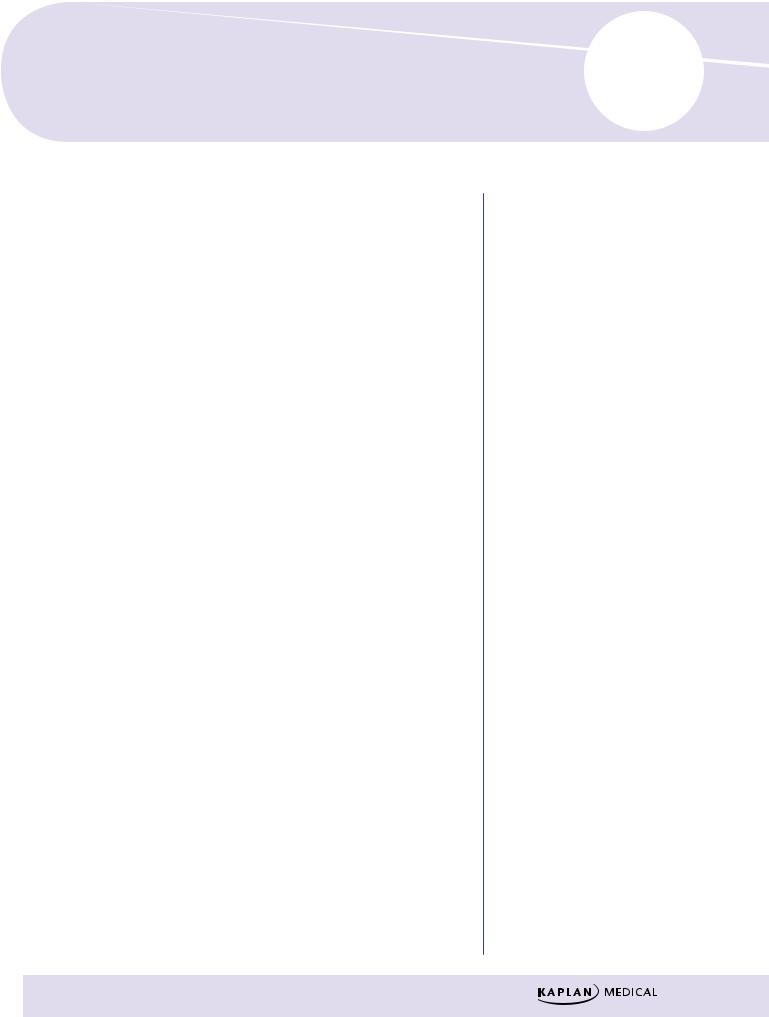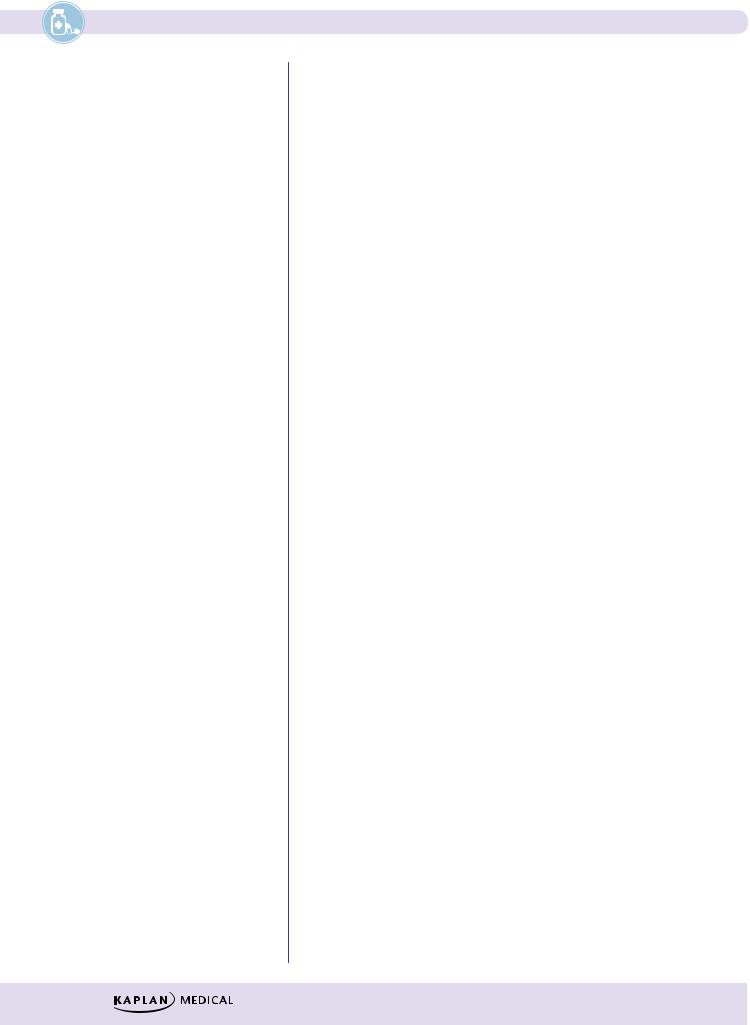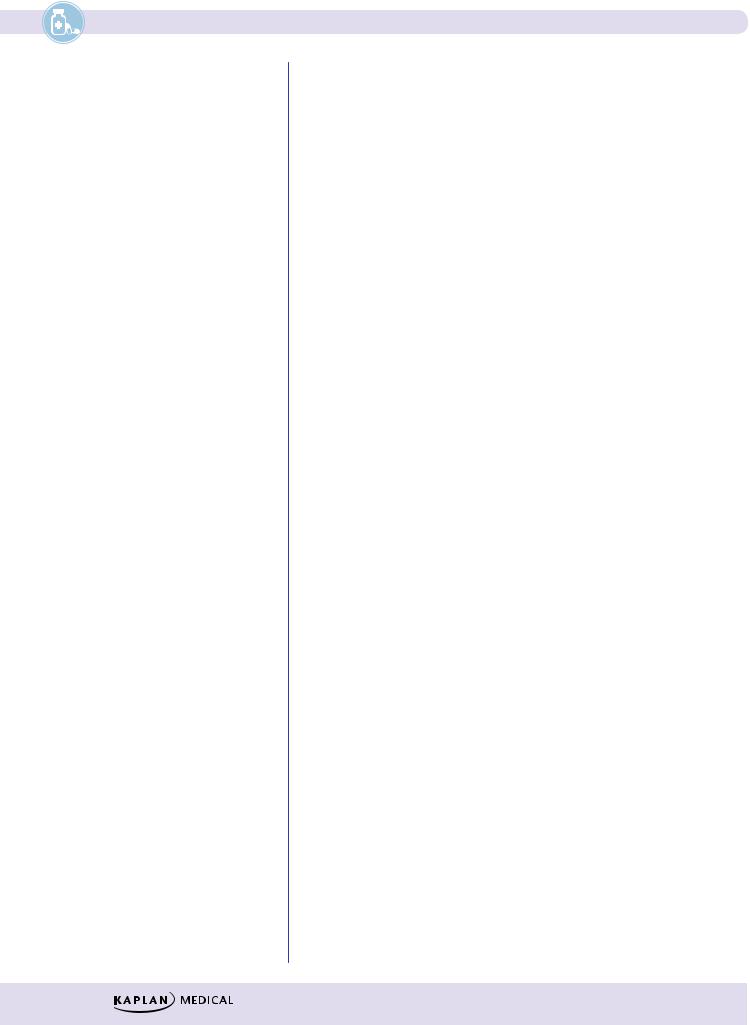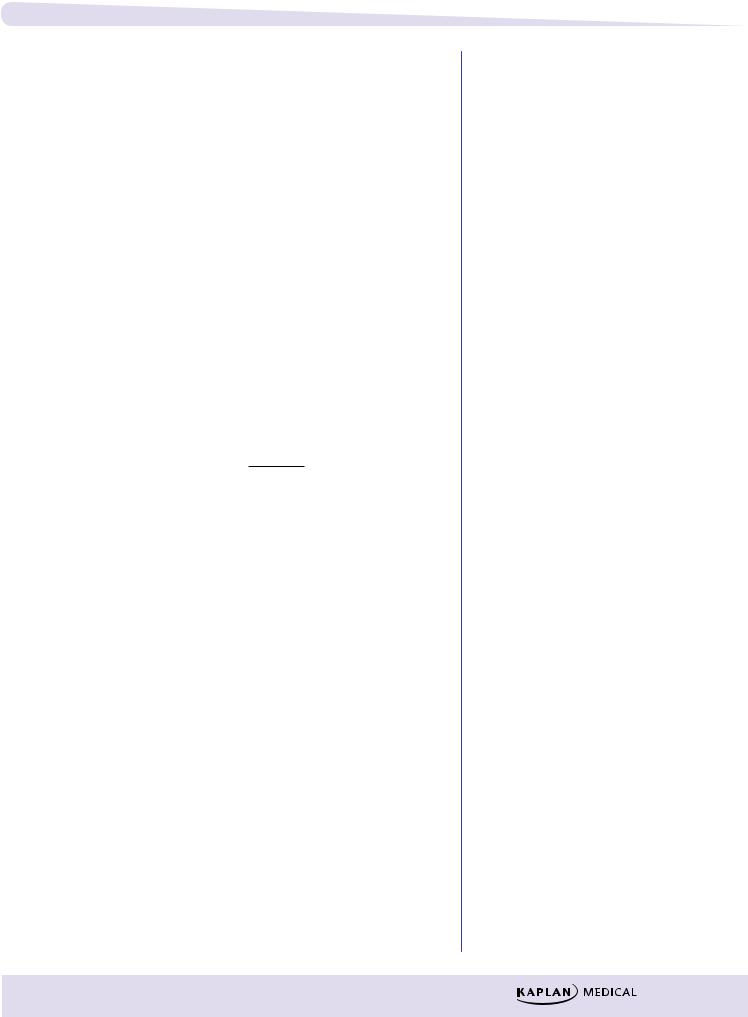
книга / 2016_Kaplan_USMLE_Step_1_Lecture_Notes_Pharmacology
.pdf
Practice Questions |
3 |
|
1.A patient was given a 200 mg dose of a drug IV, and 100 mg was eliminated during the first two hours. If the drug follows first-order elimination kinetics, how much of the drug will remain 6 hours after its administration?
A.None
B.25 mg
C.50 mg
D.75 mg
E.100 mg
2.Drugs that are administered IV are
A.Rapidly absorbed
B.Subject to first-pass metabolism
C.100% bioavailable
D.Rapidly excreted by the kidneys
E.Rapidly metabolized by the liver
3.Drugs that are highly bound to albumin:
A.Effectively cross the BBB
B.Are easily filtered at the glomerulus
C.Have a large Vd
D.Often contain quaternary nitrogens
E.Can undergo competition with other drugs for albumin binding sites
4.Most drugs gain entry to cells by:
A.Passive diffusion with zero-order kinetics
B.Passive diffusion with first-order kinetics
C.Active transport with zero-order kinetics
D.Active transport with first-order kinetics
E.Passive diffusion through membrane pores
29

Section I λ General Principles
5.A subject in whom the renal clearance of inulin is 120 mL/min is given a drug, the clearance of which is found to be 18 mL/min. If the drug is 40% plasma protein bound, how much filtered drug must be reabsorbed in the renal tubules?
A.None
B.18 mL/min
C.36 mL/min
D.54 mL/min
E.72 mL/min
6.If a drug is known to be distributed into total body water, what dose (mg) is needed to obtain an initial plasma level of 5 mg/L in a patient weighing 70 kg?
A.210
B.150
C.110
D.50
E.35
7.Which of the following is a phase II drug metabolism reaction associated with a genetic polymorphism?
A.Acetylation
B.Glucuronidation
C.Oxidation
D.Reduction
E.Glutathione conjugation
8.A woman is taking oral contraceptives (OCs). Which of the following drugs is unlikely to reduce the effectiveness of the OCs?
A.Carbamazepine
B.Phenytoin
C.Ketoconazole
D.Phenobarbital
E.Rifampin
30

Chapter 3 λ Practice Questions
9. The data presented in the figure below show that:
% Response
100 |
Drug A |
Drug B |
|
||
|
|
|
50 |
|
Drug C |
|
|
Log dose
A.Drugs A and B have equal efficacy
B.Drug B and C have equal efficacy
C.Drug B is a partial agonist
D.Drugs A and C have the same affinity and efficacy
E.Drugs A and B have equal potency
10.A 500-mg dose of a drug has therapeutic efficacy for 6 h. If the half-life of the drug is 8 h, for how long would a 1-g dose be effective?
A.8 h
B.12 h
C.14 h
D.16 h
E.24 h
11.Which statement is accurate for the drug shown in the example below?
100 mg 2hr → 50 mg 2hr → 25 mg 2hr → 12.5 mg
A.The rate of elimination is constant
B.The elimination half-life varies with the dose
C.The volume of distribution varies with the dose
D.The clearance varies with the dose
E.The rate of elimination varies directly with the dose
12.Normally, acetaminophen has a Vd = 70L and C1 = 350 mL/min. If acetaminophen was administered to a patient with 50% renal function, what parameter would differ from normal?
A.Loading dose would be higher
B.Maintenance dose would be lower
C.t ½ would be shorter
D.Vd would be 35L
E.Cl would be 700 mL/min
31

Section I λ General Principles
13.Pharmacokinetic characteristics of propranolol include Vd = 300 L/70 kg, C1 = 700 mL/min, and oral bioavailability f = 0.25. What is the dose needed to achieve a plasma level equivalent to a steady-state level of 20 μg/L?
A.4 mg
B.8 mg
C.12 mg
D.24 mg
E.48 mg
14.With IV infusion, a drug reaches 50% of its final steady state in 6 hours. The elimination half-life of the drug must be approximately:
A.2 h
B.6 h
C.12 h
D.24 h
E.30 h
15.At 6 h after IV administration of bolus dose, the plasma level of a drug is 5
mg/L. If the Vd = 10 L and the elimination half-life = 3 h, what was the dose administered?
A.100 mg
B.150 mg
C.180 mg
D.200 mg
E.540 mg
16.An IV infusion of a drug is started 400 mg/h. If C1 = 50 L/h, what is the anticipated plasma level at steady state?
A.2 mg/L
B.4 mg/L
C.8 mg/L
D.16 mg/L
E.32 mg/L
32

Chapter 3 λ Practice Questions
Answers
1.Answer B. One half of the dose is eliminated in the first two hours so its elimination half-life equals two hours. With the passage of each half-life the amount in the body (or in the blood) will decrease to 50% of a former level. Thus, at 6 hours after administration, three half-lives have passed: 1) 200 mg to 100 mg, 2) 100 mg to 50 mg, and 3) 50 mg to 25 mg.
2.Answer C. By definition, IV administration does not involve absorption because there is no movement from the site of administration into the blood. The IV route avoids first-pass metabolism which is common with orally administered drugs. First-pass greatly reduces the bioavailability of many drugs. Drugs given IV have 100% bioavailability (f = 1) since the entire dose is in the systemic circulation. No conclusions can be draw about renal or hepatic elimination of a drug knowing only that it was administered IV.
3.Answer E. Since most drugs are lipid-soluble they will need a carrier in the blood, most commonly albumin. Drugs bound to albumin do not get filtered at the glomerulus or cross the blood-brain barrier. Binding to plasma
proteins keeps drugs in the plasma resulting in a lower Vd. Highly protein bound drugs are good candidates for interactions with other drugs that are also highly bound (e.g., warfarin plus sulfonamides).
4.Answer B. The permeation of most drugs through cellular membranes is by the process of passive diffusion, a nonsaturable process that follows firstorder kinetics. Concentration gradient and lipid solubility are important determinants for the rate of diffusion. Only a few drugs are substrates for active transport processes such as active tubular secretion (e.g., penicillins) or penetrate membranes via aqueous pores (ethanol).
5.Answer D. The formula to use is Cl = ff x GFR. The drug is 40% protein bound so the ff = 60%. 120 mL/min x 60% = 72 mL/min theoretical clearance of the drug. Since only 18 mL/min was actually cleared, there must have been tubular reabsorption of the drug. 72 – 18 = 54 mL/min of reabsorbed drug.
6.Answer A. This is a “loading dose” question. The equation for loading dose
or the volume of distribution equation can be used (LD = Vd × Cp). Since the patient weighs 70 kg and 60% of body weight is water, he has 42 L (70 L x 60%) of total body water. LD = 42 L × 5 mg/L = 210 mg.
7.Answer A. Phase II drug metabolism involves the transfer of chemical groupings (e.g. acetyl, glucuronide, glutathione) to drugs or their metabolites via conjugation reactions involving transferase enzymes. Acetylation reactions are associated with a genetic polymorphism (slow acetylator). These individuals are slow to metabolize drugs via acetylation and are particularly susceptible to drug-induced SLE when taking hydralazine, procainamde, or isoniazid. Both oxidation and reduction are phase I metabolism reactions.
33

Section I λ General Principles
8.Answer C. Azole antifungals (e.g. ketoconazole) are inhibitors of cytochrome P450 enzymes, especially CYP3A4, the most abundant isozyme form in the human liver. The 3A4 isozyme metabolizes a wide range of drugs. Ketoconazole would actually raise the plasma levels of oral contraceptives increasing the risk of side effects but it would not reduce their effectiveness. All other drugs listed are P450 inducers. As such, they would tend to lower plasma levels and decrease effectiveness of oral contraceptives.
9.Answer A. The typical log dose response figure with the parallel nature of the curves suggests that the three drugs are interacting with the same receptor system. Drugs A and B are full agonists because they achieve the maximal response. They have the same efficacy. Drug A is more potent than drugs B or C. Drug B is more potent than drug C. Drug C is a partial agonist with less efficacy than the full agonists.
10.Answer C. The fact that the drug has therapeutic efficacy for 6 h has no direct relationship to its half-life—it simply means that the drug is above its minimal effective concentration for 6 h. Doubling the dose (to 1 g) means that the drug level will be above the minimum for a longer period. Because the elimination half-life is 8 h, 500 mg of the drug will remain in the body 8 h after a dose of 1 g. Thus, the total duration of effectiveness must be 8 + 6 = 14 h.
11.Answer E. In first-order kinetics, the elimination rate of a drug is directly proportional to its plasma concentration, which in turn is proportional to the dose. Drugs that follow first-order elimination have a constant elimination half-life similar to the example given in the question. Likewise, clearance and volume of distribution are pharmacokinetic characteristics of a drug that do not routinely change with dose, although they may vary in terms of disease or dysfunction.
12.Answer B. The patient in the question has renal dysfunction which reduces renal clearance. This would necessitate a lower maintenance dose for medications such as acetaminophen.
|
Cl × Css x τ |
|
The maintenance dose equation (MD = |
|
) factors in renal |
|
||
|
f |
|
clearance while the loading dose equation does not. The t ½ of acetaminophen would be increased in this patient due to the decrease in clearance, but the Vd would be unaffected.
13. Answer D. Loading dose = V |
|
× |
Cp |
|
LD = 300L × 20 μg/L ÷ 0.25 |
|
d |
f |
|||||
|
|
|
||||
|
|
|
|
|||
= 6000 μg/0.25 |
= 24,000 μg or 24 mg |
|||||
14.Answer B. The rules for time to steady-state are that it takes 4-5 t ½ to reach clinical steady-state. It also takes one t ½ to get half way to steady-state. Since the drug got 50% of the way to steady-state in 6 hours, its t ½ must be 6 hours.
34

Chapter 3 λ Practice Questions
15.Answer D. At 6 h after IV injection (which corresponds to two half-lives of the drug), the plasma level is 5 mg/L. Extrapolating back to zero time, “doubling” plasma level for each half-life results in an initial plasma level at zero time (C0) = 5 mg/L × 2 × 2 = 20 mg/L.
Dose = C0 x Vd
=20 mg/L × 10 L
=200 mg
16.Answer C. MD = Cl × Css × τ
Since the drug was given by constant IV infusion there is no need to consider the dosing interval (τ). Therefore, 400 mg/h = 50 L/h x Css
400 mg/h ÷ 50 L/h = 8 mg/L
Alternatively, you could evaluate the question this way:
An infusion rate (k0) is given by:
k0 = Cl × Css rearrange: Css = k0/Cl
= |
400 mg/h |
= 8 mg/L |
50 L/h |
35

SECTION II
Autonomic
Pharmacology
